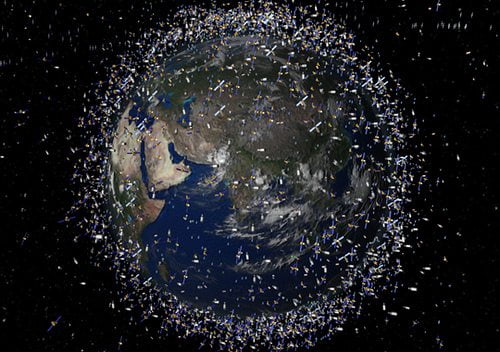

Environment
Scientists to use ‘harpoon’ to reel in dangerous space debris
Faced with the very 21st century problem of space debris – the bits and pieces from thousands of space missions that litter Earth’s orbit – scientists are turning to stone age technology: the harpoon.
When we think about pollution, we usually do not think further than our own planetary boundaries. But mankind is not only polluting the Earth’s atmosphere, we’re polluting its orbit, too.
Only a small percentage of the manmade objects in space are functioning satellites. Scientists say that there are more than 300,000 pieces of debris in space, including screws and bolts, large parts of rockets, spatulas and gloves.
This growing halo of junk is a serious threat to functioning satellites and future space missions, as the risk of collisions increase. In orbit, even a 1cm object can be travelling so fast that a collision could be devastating.
There has already been four major collisions in low Earth orbit. The most serious was in 2009, when an Iridium Communications satellite collided with a defunct Russian Space Forces satellite at over 25,000 miles per hour.
Scientists also fear that a large collision could set off a chain reaction, creating many more pieces of debris in a self-sustaining cycle. This kind of threat was recently portrayed in the 2013 film Gravity.
The loss of satellites caused in such an event would also have a massive impact on the global economy.
Heiner Klinkrad, head of the European Space Agency’s (ESA) space debris office, said in 2013, “Our understanding of the growing space debris problem can be compared with our understanding of the need to address Earth’s changing climate some 20 years ago.
“While measures against further debris creation and actively deorbiting defunct satellites are technically demanding and potentially costly, there is no alternative to protect space as a valuable resource for our critical satellite infrastructure.
Experts say that the only way to reduce the risk is to remove large items such as disused satellites and pieces of rockets from lower orbits. To do this, experts are now suggesting we use a tool invented in Palaeolithic times.
A prototype harpoon has been tested by Airbus Defence and Space at its facilities in Stevenage, ahead of the ESA’s planned 2021 e.DeOrbit mission.
The autonomously controlled flight will identify large objects at between 800-1,000 km altitude, securing debris before dragging it down to be burnt-up entering the Earth’s atmosphere.
The ESA has considered many different mechanisms, from throw nets to robotic arms, but harpoons can reel in targets of any attitude and shape, and do not require close operations.
Now, the space agency plans to build and test a prototype harpoon, in the hope of using it for the crucial mission. The ESA has called for bidders to compete for the project contract.
An even more seemingly outlandish idea has recently been put forward by scientists in Australia, who proposed using advanced laser technology to “zap” debris down to Earth.
Photo: keithfiore via Flickr
Further reading:
Space debris to be cleared using lasers, Australian scientists say
Space junk: the abuse of the abyss


 Environment10 months ago
Environment10 months agoAre Polymer Banknotes: an Eco-Friendly Trend or a Groundswell?

 Environment11 months ago
Environment11 months agoEco-Friendly Home Improvements: Top 7 Upgrades for 2025

 Features9 months ago
Features9 months agoEco-Friendly Cryptocurrencies: Sustainable Investment Choices

 Features10 months ago
Features10 months agoEco-Friendly Crypto Traders Must Find the Right Exchange






























